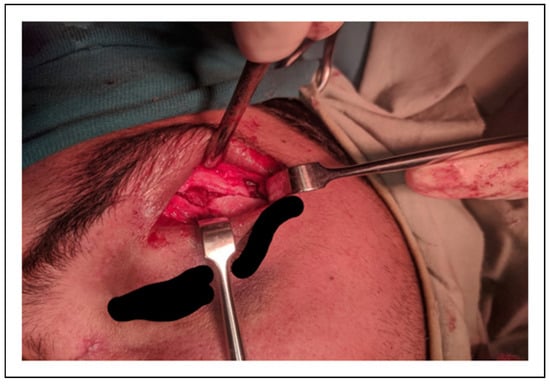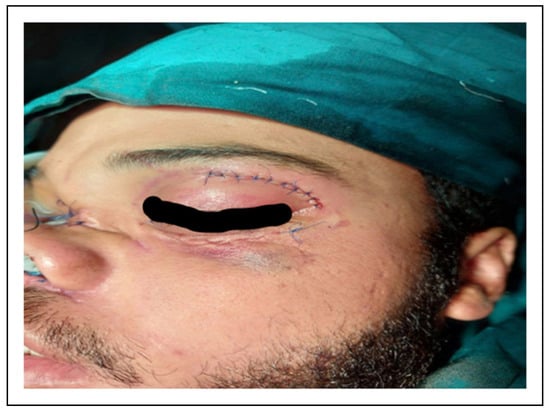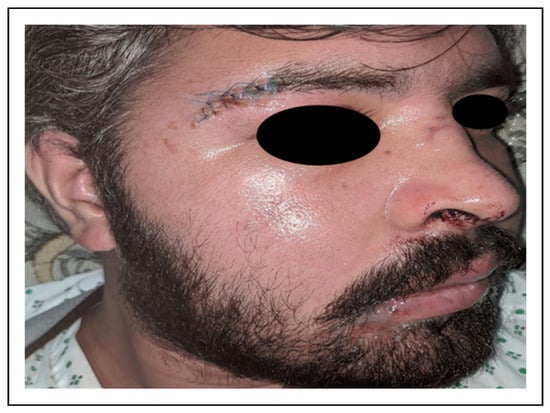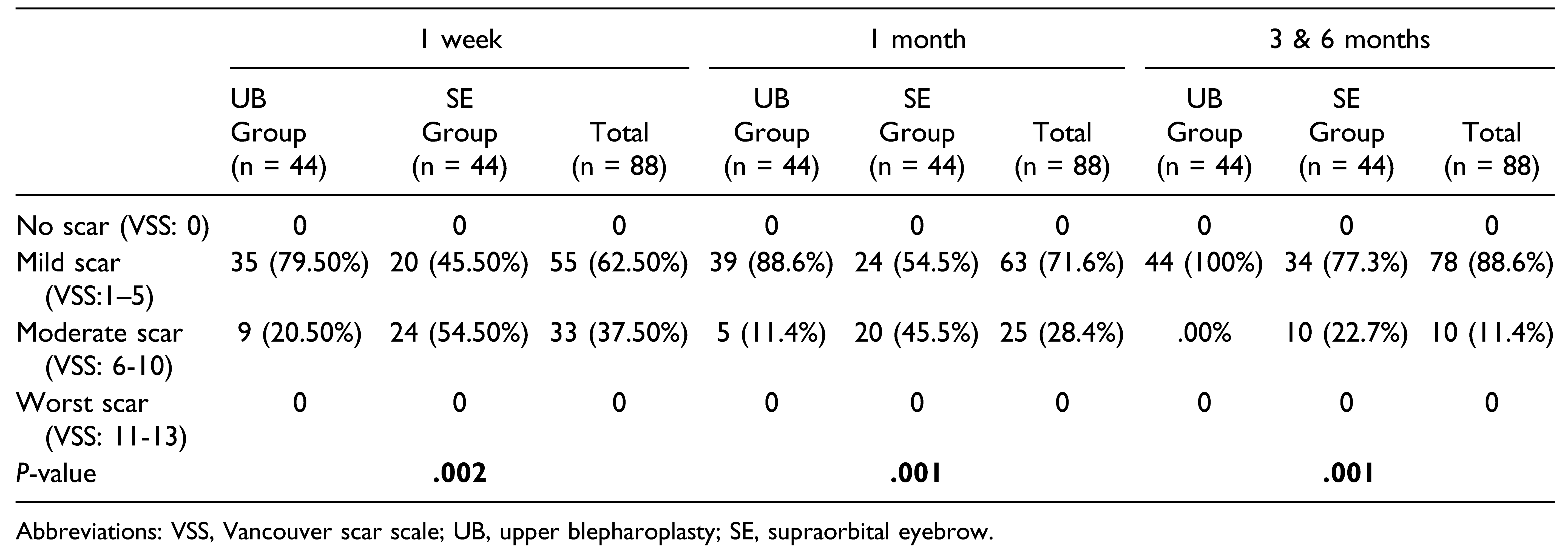Abstract
Study Design: A prospective randomized comparative study was conducted to evaluate the postsurgical scar with Supraorbital Eyebrow (SE) Approach and Upper Blepharoplasty (UB) Approach used for open reduction and internal fixation (ORIF) of zygomaticomaxillary complex (ZMC) fractures. Objective: To evaluate and compare the post-operative scar using Vancouver Scar Scale (VSS) following ORIF of ZMC fractures with SE and UB approaches. Methods: In this study, 88 patients with ZMC fractures requiring ORIF and meeting the inclusion criteria were recruited between 2019 and 2020. Patients were randomly divided into SE and UB group, 44 patients in each. Clinical and radiological assessment was done preoperatively and post-operative scar evaluation was carried out at different intervals over a period of 6 months using VSS. A blinded observer rated the scar. Results: The results showed that after 6 months of surgery, all the 44 (100%) patients in UB group had a mild scar (VSS score 1–5), while in the SE group 34 (77.3%) patients had a mild scar (VSS score 1–5) and 10 (22.7%) had a moderate scar (VSS score 6–10). The difference between the 2 groups was statistically significant (P-value = .001). Conclusions: The UB approach has been established to be superior to SE approach in terms of post-operative scar as the results were statistically significant. This study can be used to advocate more frequent use of UB approach as compared to the previously popular SE approach for the management of ZMC fractures.
Introduction
The face is the most noticeable structure of the human anatomy and because of its prominence, it is frequently affected in traumatic injuries []. The zygomaticomaxillary complex (ZMC) is the most common site of fracture in the midfacial region owing to its projecting, convex shape []. The diagnosis is made on clinical and radiographic evidence. Fractures of ZMC can result in significant functional and esthetic deformities [].
An accurate grasp of the anatomic landmarks of zygomatic bone and its articulations is mandatory to plan the appropriate incision and fixation technique for the particular fracture []. A direct blow to the malar region can result in fracture of the zygomatic complex typically along the suture lines as they are weaker and more susceptible to fracture. These fracture lines typically course through the zygomaticomaxillary buttress, through to the infraorbital rim and involve the frontozygomatic suture and the zygomatic arch. These fractures are often termed as tripod or tetrapod fractures depending on the number of sutures involved as proposed by Zingg and colleagues [].
An optimal surgical incision to expose the ZMC fracture should give adequate access, minimize risk of damaging facial soft tissues as well as neurovascular structures and should be esthetically acceptable to the patient in terms of the post-operative scar []. Frontozygomatic process fracture can be accessed by lateral eyebrow, upper blepharoplasty, transconjunctival, and coronal approaches. Supraorbital eyebrow approach is an old and popular approach which is simple, provides rapid access to the frontozygomatic suture and has no significant neurovascular structures in its vicinity. However, it leaves a visible postsurgical scar and can result in hair growth retardation in the eyebrow region [,]. In this modern age, focus is shifting from reducing the postsurgical scar to virtually eliminating it. Another approach which is gaining popularity is the upper blepharoplasty approach which uses the upper eyelid crease to gain access to the frontozygomatic process through lateral dissection. It has the advantage of leaving an inconspicuous scar as it follows the skin tension lines of the upper eyelid. Furthermore, there is no risk of damaging any neurovascular structures when the incision follows tissue planes [,].
Aesthetics are a major concern for the patient as well as the surgeon regarding any kind of facial surgery. Hence, this study has been designed to evaluate the aesthetic property of supraorbital eyebrow approach in comparison to upper blepharoplasty approach in terms of postoperative scar after open reduction and internal fixation of ZMC fractures.
Patients and Methods
All the patients sustaining ZMC fractures were treated at Department of Oral and Maxillofacial Surgery, Pakistan institute of Medical Sciences between 2019 and 2020. Patients were included in the study after clinical and radiographic diagnosis of ZMC fractures. The classification proposed by Zingg and colleagues [] (1992) was used in this study because of its simplicity and usefulness in treatment planning. Under this system, class B fractures which represent tripod/tetrapod fractures were included in the study. Patients were randomized into 2 groups, that is, SE group and UB group with 44 patients in each group. All patients were explained in the language they understood, the aim and objectives, procedure, follow-up, investigations, and possible adverse effects. They were given a detailed patient information sheet and informed consent was sought. All the protocols were approved by the institutional ethical review committee.
Inclusion Criteria
- Patients with clinically and radiographically diagnosed tripod/tetrapod fracture of ZMC
- Patients in the age group of 18–60 years.
- The time gap between the day of trauma to hospital admission should be <3 weeks
- Subject consent to participate.
Exclusion Criteria
- Medically compromised patients unfit for major surgery
- Previously treated frontozygomatic process fractures
- Infected frontozygomatic process fractures
- Frontozygomatic process fractures with associated open wound
The surgery in both the groups was performed by the same surgical team. Depending upon the fracture pattern and the reduction achieved, two or three-point fixation was carried out. The frontozygomatic suture was repaired first via SE approach in one group and UB approach in the other, followed by zygomaticomaxillary buttress via intraoral vestibular approach in both groups then infraorbital rim was repaired via rim approach if indicated in both groups. Post-operative scar assessment of SE and UB incisions was carried out at different intervals, that is, 1 week, 1 month, 3 months, and 6 months using Vancouver Scar Scale (0: No scar–13: Worst scar) based on four properties of scar namely vascularity, pigmentation, pliability, and height. A blinded observer rated the scar. Additional documentation included patient demographics and etiology of fracture.
Surgical Procedure
Upper Blepharoplasty Approach. Under aseptic protocol, incision was placed in the upper eyelid crease, 10 mm superior to the upper eyelid margin from mid pupil to lateral orbital rim in a curvilinear fashion. Supra periosteal dissection was carried out superiorly and laterally over the lateral orbital rim, exposing periosteum. Subperiosteal dissection was then done to access the fracture (Figure 1) [12]. Reduction was performed under direct vision and fixation was done with 2 mm diameter titanium micro plates and screws 5 mm in length (Figure 2). A layered closure was performed. Periosteum and muscle layer was closed with Vicryl 4-0 suture. Skin was closed with Proline 5-0 suture (Figure 3),(Figure 1, Figure 2, Figure 3, Figure 4 and Figure 5).

Figure 1.
Intraoperative exposure of fracture through upper blepharoplasty incision.

Figure 2.
Intraoperative fixation of fracture through upper blepharoplasty approach.

Figure 3.
Closure of upper blepharoplasty incision.

Figure 4.
Intraoperative exposure of fracture through supraorbital eyebrow approach.

Figure 5.
Closure of supraorbital eyebrow incision.
Supraorbital Eyebrow Approach. Under aseptic protocol, an incision of 2 cm was placed within the extent of lateral eyebrow parallel to the hair shafts down to the periosteum. The incision was extended inferiorly, if necessary for improved access. Subperiosteal dissection was carried out to expose the fracture (Figure 4) []. Fracture was reduced under direct vision and fixation was done with 2 mm in diameter titanium micro plates and screws of 5 mm in length. Closure was done in layers. Periosteum and muscle layer was closed with Vicryl 4-0 suture. Skin was closed with Proline 5-0 suture (Figure 5).
Statistical Analysis. All statistical analysis were performed using the SPSS software. Categorical data were represented using frequencies and percentages and continuous data were described using mean and standard deviations.
For categorical data, Chi-square test was used and for continuous data, t-tests were used. For comparison of data collected over multiple intervals of time, a general linear model of repeated measures analysis of variance (ANOVA) was used. Relationship between variables was assessed using Pearman’s rank correlation coefficient. An α-level of .01 was used as a cut-off for statistical significance along with 95% confidence interval.
Results
Demographic Results
The patients in the study were divided into two age groups of (18–40) and (41–60) years. The results showed that 78 (88.6%) patients were in the 18–40 years age group while only 10 (11.4%) were in the 41–60 age group. The difference in age between the 2 groups was statistically significant (P = .045). There was also a marked male predominance with 79 (89.8%) males and only 9 (10.2%) females (P = .00) (Table 1). The patients in this study reported with 3 etiological factors namely road traffic accidents (RTA), falls and assault. RTA came out to be the most frequent cause of fractures with 59 (67%) patients, followed by falls with 23 (26.1%) and assaults with 6 (6.8%) patients (P = .003) (Table 2).

Table 1.
Distribution of the Participants of Both Groups According to Age and Gender.

Table 2.
Distribution of the Participants of Both Groups According to Age and Gender.
Clinical Results
Scar Assessment: Vancouver Scar Scale (VSS) is a systematic tool which was used to assess the post-operative scar in both groups at 1 week, 1 month, 3 months and 6 months. It takes into account 4 properties of the scar namely vascularity, pigmentation, pliability and height. An overall score of 0–13 is assigned to the scar ranging from best to worst. The score was divided into 3 categories, that is, mild scar (VSS score 1–5), moderate scar (VSS score 6–10), and worst scar (VSS score 11–13).
Scar at 1 week: At 1 week, in SE group, out of 44 patients, 20 (45.5%) had mild scar (VSS score 1–5) while 24 (54.5%) had moderate scar (VSS score 6–10). In the UB group, 35 (79.5%) patients had a mild scar whereas 9 (20.5%) had a moderate scar. The difference in the scar quality between the 2 groups was statistically significant (P = .002).
Scar at 1 month: After 1 month, scar quality improved in both groups, with 24 (54.5%) patients having a mild scar and 20 (45.5%) having a moderate scar in SE group whereas in UB group, 39 (88.6%) patients had a mild scar and only 5 (11.4%) had a moderate scar (P = .001).
Scar at 3 and 6 months: The post-operative scar evaluation at 3 months showed improvement in both the groups. Furthermore, scar score did not alter after 3 months in both groups. Final assessment at 6 months post-op showed that 34 (77.3%) patients in SE group had a mild scar while 10 (22.7%) had a moderate scar. In the UB group, all 44 (100%) patients had a mild scar (P = .001) (Table 3).

Table 3.
Distribution of the Participants of Both Groups According to Age and Gender.
A repeated measure ANOVA test showed that the scar assessment scale significantly got better over time F (1.388) = 22.661, (P < .001).
Discussion
The management of zygoma fractures has been constantly evolving over the passage of time. Early function, patient comfort and pleasing aesthetics have become goals of modern surgery [13]. Numerous surgical procedures have been introduced in the recent times which permit sufficient access for open reduction of fractures while minimizing post-operative scarring. Aesthetic incisions such as transconjunctival, transoral, and upper blepharoplasty incisions are now popularly being employed for treating orbito-zygomatic fractures with inconspicuous scars and minimal complications, whereas conspicuous incisions such as sub-ciliary, infraorbital, and lateral eyebrow incisions are finding lesser and lesser use these days [14].
Frontozygomatic process is one of the most commonly involved structures in midfacial trauma. It is a vital site of fixation as it is the most stable articulation of zygoma and provides three-dimensional stability to the complex [15]. The main concern regarding the treatment of this region is post-operative scarring, infection and hardware palpability as there is lesser soft tissue coverage in this region as compared to other areas of the face [16]. Thus, the correct surgical approach, selection and precise placement of the hardware and meticulous closure are paramount for achieving optimal results.
Scar formation is inevitable after any kind of invasive surgery but it is a source of great concern in facial surgeries wherein aesthetics is the cornerstone of treatment. Facial scars can be aesthetically displeasing and can cause negative psychosocial effects such as depression and decreased self-esteem [17]. Scar evaluation has been done over the passage of time with development of various scar scales. These scales provide a qualitative and quantitative assessment of the scar properties which can be used to compare various scars and influence scar management therapy [18]. The VSS which was introduced in 1990 is still the most widely used scar assessment scale. This scale centers on four parameters, that is, scar vascularity, pigmentation, pliability, and height [19]. The scale uses these parameters to produce a score ranging from 0 to 13. The increase in overall score indicates worsening of the appearance of the scar. In this study, we have used the VSS to compare postsurgical scar of SE and UB incision between the two study groups for the ORIF of ZMC fractures and assigned grades according to the scores on the scale, that is, no scar (VSS score 0), mild scar (VSS 1–5), moderate scar (VSS 6-10), and worst scar (VSS 11–13).
Post-surgical scar evaluation was carried out for both groups at intervals of 1 week, 1 month, 3 months, and 6 months on the VSS. Our results showed that on the 1st week, 79.5% patients treated by UB approach had a mild scar while 20.5% had a moderate scar. In the SE group, 45.5% had a mild scar while 54.5% had a moderate scar. The higher number of moderate scars by the end of the 1st week can be explained by the inflammatory and proliferative phases of wound healing in which there is migration of inflammatory mediators, angiogenesis, granulation tissue formation, collagen deposition, and epithelialization [20]. This plethora of processes gives an unsightly appearance to the wound in the first week.
The number of cases with moderate scar dropped slightly at the end of 1 month in both groups. UB group demonstrated a mild scar in 88.6% of patients and a moderate scar in 11.4% patients. In the SE group, 54.5% patients had a mild scar whereas 45.5% had a moderate scar. The slight improvement in scar quality in both groups at 1 month interval is related to the completion of epithelialization and wound contraction. Linear scar contraction takes place from both scar ends to the center [21].
There was significant improvement in the scar quality noted by the end of 3 and 6 months in both groups. However, it is noted that the wound of UB incision is less conspicuous than that of SE group in all the 4 intervals. In the UB group, all patients (100%) had a mild scar. In the SE group, 77.3% patients had a mild scar while 22.7% still had a moderate scar. The final or remodeling phase of wound healing starts after 1 month of injury and involves a decline in fibroblast count, occlusion of blood vessels, continuous production of collagen, and replacement of type 1 by type 3 collagen resulting in a remodeling effect making the wound well organized, similar to unwounded skin. After this phase, the production and degradation balance each other and no significant change in the scar is observed [22].
Reschke et al. [] conducted an anthropometric study on surgical outcome of zygomaticomaxillary fractures. He measured the effectiveness of both SE and UB approach and concluded that the latter approach is superior to the former as it is placed in the skin crease, leaving an inconspicuous scar. Kim et al. [] performed SE approach for ORIF of 16 patients and found that 10 (63%) had unsightly scars at the frontozygomatic region. The results of these studies match our results and further validate the aesthetic property of UB approach in comparison with SE approach. The UB approach scored less in the VSS as compared to SE approach in all intervals over the course of 6 months. The difference between the two was statistically significant (P < .05). The factors which govern these results are mainly related to the anatomical landmarks of the incisions. The SE incision begins in the hair shafts of the lateral eyebrow and is often extended inferiorly for access to the frontozygomatic suture crossing the resting skin tension lines perpendicularly resulting in a visible scar. In addition, it occasionally leads to alopecia along the eyebrow []. The UB approach uses the natural upper eyelid skin crease along the resting skin tension lines to gain access to the frontozygomatic suture that results in an imperceptible scar making it an ideal choice for repair of lateral orbital fractures [14,23].
There were a few limitations in this study. First, a population of only one ethnicity could be included in the study. Different skin complexions can affect the outcome. Another limitation was that postsurgical care of the wound at home could not be monitored as the patients were discharged 3 days after the procedure. It is recommended to conduct further research and larger scale studies that include population of different ethnic groups so that post-operative scars could be compared on contrasting skin complexions.
Conclusions
The results of this study show that there is sufficient evidence to draw the conclusion that UB approach is superior to SE approach in terms of post-operative scar in the treatment of ZMC fractures. The findings of this study can be used to inform guidelines on the best surgical approaches for managing ZMC fractures.
Funding
The authors received no financial support for the research, authorship, and/or publication of this article.
Conflicts of Interest
The authors declared no potential conflicts of interest with respect to the research, authorship, and/or publication of this article.
References
- Modabber, A.; Rana, M.; Ghassemi, A.; et al. Three-dimensional evaluation of postoperative swelling in treatment of zygo- matic bone fractures using two different cooling therapy methods: a randomized, observer-blind, prospective study. Trials. 2013, 14, 1–10. [Google Scholar] [CrossRef] [PubMed]
- Udeabor, S.; Akinmoladun, V.I.; Olusanya, A.; Obiechina, A. Pattern of midface trauma with associated concomitant in- juries in a Nigerian referral centre. Niger J Surg. 2014, 20, 26–29. [Google Scholar]
- Noor, M.; Ishaq, Y.; Anwar, M.A. Frequency of infra-orbital nerve injury after a Zygomaticomaxillary complex fracture and its functional recovery after open reduction and internal fixation. Int Surg J. 2017, 4, 685–689. [Google Scholar] [CrossRef]
- Barta, R.J.; Schubert, W. Ratio of simple versus comminuted lateral wall fractures of the orbit. Craniomaxillofacial Trauma Reconstr. 2013, 6, 241–245. [Google Scholar] [CrossRef]
- Zingg, M.; Laedrach, K.; Chen, J.; et al. Classification and treatment of zygomatic fractures: a review of 1, 025 cases. J Oral Maxillofac Surg. 1992, 50, 778–790. [Google Scholar] [CrossRef]
- Marinho, R.O.M.; Freire-Maia, B. Management of fractures of the zygomaticomaxillary complex. Oral Maxillofac Surg Clin 2013, 25, 617–636. [Google Scholar] [CrossRef] [PubMed]
- Thangavelu, K.; Ganesh, N.S.; Kumar, J.A.; Sabitha, S. Evaluation of the lateral orbital approach in management of zygomatic bone fractures. J Nat Sci Biol Med. 2013, 4, 117. [Google Scholar] [CrossRef]
- Kim, S.T.; Go, D.H.; Jung, J.H.; Cha, H.E.; Woo, J.H.; Kang, I.G. Comparison of 1-point fixation with 2-point fixation in treating tripod fractures of the zygoma. J Oral Maxillofac Surg. 2011, 69, 2848–2852. [Google Scholar] [CrossRef]
- Raschke, G.F.; Rieger, U.M.; Bader, R.D.; et al. The zy- gomaticomaxillary complex fracture–an anthropometric ap- praisal of surgical outcomes. J Cranio Maxillofac Surg. 2013, 41, 331–337. [Google Scholar] [CrossRef]
- Golan, S.; Goldberg, R.A. Time course analysis of upper blepharoplasty complications. Dermatol Surg. 2017, 43, 307–309. [Google Scholar] [CrossRef]
- 11. Candamourty, R.; Narayanan, V.; Baig, M.; Muthusekar, M.; Jain, M.K.; Babu, R.M. Treatment modalities in zygomatic complex fractures: A prospective short clinical study. Dent Med Res. 2013, 1, 13. [Google Scholar] [CrossRef]
- Strong, E.B.; Gary, C. Management of zygomaticomaxillary complex fractures. Facial Plast Surg Clin. 2017, 25, 547–562. [Google Scholar] [CrossRef]
- Rallis, G.; Stathopoulos, P.; Igoumenakis, D.; Krasadakis, C.; Mourouzis, C.; Mezitis, M. Treating maxillofacial trauma for over half a century: how can we interpret the changing patterns in etiology and management? Oral Surg Oral Med Oral Pathol Oral Radiol. 2015, 119, 614–618. [Google Scholar] [CrossRef] [PubMed]
- Markiewicz, M.R.; Gelesko, S.; Bell, R.B. Zygoma reconstruc- tion. Oral Maxillofac Surg Clin. 2013, 25, 167–201. [Google Scholar] [CrossRef]
- Kochhar, A.; Byrne, P.J. Surgical management of complex midfacial fractures. Otolaryngol Clin. 2013, 46, 759–778. [Google Scholar] [CrossRef]
- Tripathi, N.; Goyal, M.; Mishra, B.; Dhasmana, S. Zygomatic complex fracture: a comparative evaluation of stability using titanium and bio-resorbable plates as one point fixation. Natl J Maxillofac Surg. 2013, 4, 181. [Google Scholar]
- Monstrey, S.; Middelkoop, E.; Vranckx, J.J.; et al. Updated scar management practical guidelines: non-invasive and invasive measures. J Plast Reconstr Aesthetic Surg. 2014, 67, 1017–1025. [Google Scholar] [CrossRef]
- Nguyen, T.A.; Feldstein, S.I.; Shumaker, P.R.; Krakowski, A.C. A review of scar assessment scales. Semin Cutan Med Surg. 2015, 34, 28–36. [Google Scholar] [CrossRef]
- Gankande, T.; Wood, F.; Edgar, D.; et al. A modified vancouver scar scale linked with TBSA (mVSS-TBSA): inter-rater re- liability of an innovative burn scar assessment method. Burns. 2013, 39, 1142–1149. [Google Scholar] [CrossRef] [PubMed]
- Ud-Din, S.; Bayat, A. Non-invasive objective devices for monitoring the inflammatory, proliferative and remodelling phases of cutaneous wound healing and skin scarring. Exp Dermatol. 2016, 25, 579–585. [Google Scholar] [CrossRef]
- Sofie Pinney, D. Perioperative management of painful scars. 2014. [Google Scholar]
- Son, D.; Harijan, A. Overview of surgical scar prevention and management. J Kor Med Sci. 2014, 29, 751–757. [Google Scholar] [CrossRef] [PubMed]
- Ishida, K. Evolution of the surgical approach to the orbitozy- gomatic fracture: From a subciliary to a transconjunctival and to a novel extended transconjunctival approach without skin in- cisions. J Plast Reconstr Aesthetic Surg. 2016, 69, 497–505. [Google Scholar] [CrossRef] [PubMed]
© 2022 by the author. The Author(s) 2022.


